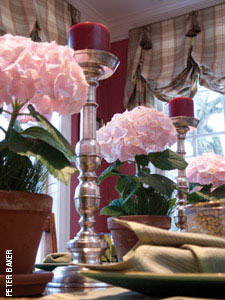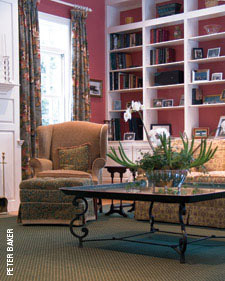Lights, Flowers, Action!
Your Home as Star of the Stage
By Jim Montalto
Photographs by Peter Baker
Imagine this home-seller’s nightmare: A 5,000 square foot colonial in Weston went on the market at $1,025,000. With a huge great room full of picture windows and skylights and a solid cherry, custom designed English-style library, it seemed like a candidate for a quick sale. But no buyer ever returned for a second look. The price was dropped – and dropped again. Eventually, the owners took it off the market while they pondered what it would take to make the house saleable.
solid cherry, custom designed English-style library, it seemed like a candidate for a quick sale. But no buyer ever returned for a second look. The price was dropped – and dropped again. Eventually, the owners took it off the market while they pondered what it would take to make the house saleable.
Deep down, both husband a wife had a pretty good idea where the root of the problem lay, and they knew the fix would cost a bundle. The problem was the floor in the great room. Its carpet was 20 years old and with stains and bare threads, it looked it. Beneath the carpet was a plywood subfloor. So, after a year and a half, they bit the bullet, installed a lovely 5-inch wide ash floor for $13,000 and put the house back on the market at just under a million. There were two offers at the asking price before the realtor’s sign was planted in the front yard.
This is a true story that occurred this year in Weston’s sister town of Weston, Connecticut. It is a somewhat extreme example of a practice that goes by the name of “staging.” Whether it is a heroic effort, such as a $13,000 floor, or simple room-by-room decluttering, staging can have an enormous impact on a home’s marketability.
“Potential buyers form an image within the first ten seconds of reviewing a property,” says Weston-area real estate broker Roberta Fitzgerald. “If they have a poor perception of the home, agents and buyers can repeatedly parade through a home without a single bid, or offer a price considerably less than expected, which can be frustrating.”
Eradicating potential negatives by creating a look more suitable to buyers can dramatically tilt the home selling experience in favor of the seller. When inspecting a property, most buyers cannot visualize changes they’d make that reach beyond what they see in front of them. Those who can, expect the seller to considerably reduce the sale price as compensation for enhancements they think will improve the house. Staging a home can help sellers break through these potential price barriers.
“The concept of home staging is like building a set inside your home. You’re taking your home and trying to create an illusion that a perspective buyer is seeking,” says Susan Dearborn, who runs an interior design consulting firm in Wellesley Hills.
Part of that illusion is curb appeal, or how the home appears from the outside. If the front yard offers a negative first impression, buyers may not even enter the house. That’s why professional stagers will freshen up the home exterior by restoring broken door handles, replacing chipped brick or stone paths, cleaning out flowerbeds and fixing visibly cracked windows.
The United Kingdom stakes claim to originating the home staging concept, but for as long as brokers have sold homes, some type of preparations were made to increase selling potential, whether it was sweeping the walk, placing a vase full of colorful flowers on a foyer table or re-arranging photos in the living room. Staging has been widely accepted on the West Coast for several years now, but it’s just recently become popular in New England.
“New Englanders are entrenched in tradition. It’s hard to let go of their possessions, their treasures,” surmises Dearborn, who helps brokers stage homes. “The idea of staging is not complicated. The most difficult part is convincing the seller how to make their house more market friendly.”
Dearborn does this by asking sellers, who are buyers too in most cases, about the most attractive features they saw in the homes they’re considering. Then she’ll incorporate those ideas into the seller’s home. To improve curb appeal, for example, she’ll recommend displaying photos that depict the home in all four seasons, which offers a better perception of the grounds with flowers and grass, even if the house is on the market in the gray New England winter.
In some cases, staging may involve packing favorite lamps or clearing away small items that clutter shelves or fireplace mantels. In more severe cases, it might require painting entire rooms, stripping rugs, or re-arranging furniture to better fit a room.
“It’s helpful if the client can understand that decorating to live and decorating to sell are two different things,” says Fitzgerald, who established the Sudbury re-design and staging firm Lipstick and Rouge to enhance the services of her broker business.
Today’s homeowners prefer hardwood floors on the first floor, so removing faded carpets, re-finishing the wood underneath, and then adding an area rug for color all capture that “decorating to sell” image. Remaining carpets should be professionally cleaned too.
Some consultants purchase entirely new items like lamps, pictures and even furniture to give each room a fresh look, but Fitzgerald doesn’t. She prefers instead to walk the house with a client and suggest what to re-arrange or take away. In some cases, it’s simply undoing what a designer has done when a client initially moves in.
“Decorators will put furniture together to create intimate areas for discussion, which is fine, but it makes the room look small. I’ll move chairs away from a fireplace to open the room a bit. Removing big items is a simple way to making a room look brighter,” she says as she recalls a large, porcelain rooster that a client had set atop an island in the middle of the kitchen.
“It was beautiful, but it took away from the appeal of the large, open kitchen because all anyone could focus on was the rooster.”
Dearborn takes a hard look at kitchens and bathrooms, since they have tremendous influence on a home’s price point. Formica tops make a place look dated, she says, but that can be an asset these days because the retro look is popular again. If the cabinets and floors are in good shape, though, it could be worth spending the money on a new marble counter. Fitzgerald insists on a spotless kitchen. Polish silver, clean dusty china and crystal, and wash the top and interior of the refrigerator. Re-stain doors and make sure all cabinets and knobs match too.
Some stagers recommend packing away personal effects like photos and memorabilia from family vacations because they serve as a distraction. Fitzgerald thinks staging should encourage perspective buyers to focus on the home’s architecture. Rooms shouldn’t distract, but instead help potential buyers imagine how they’ll design the home.
Dearborn disagrees. She says most people like looking at personal items in the home because it helps them feel that they too can fashion cozy surroundings similar to what the current owner has created.
“A kid’s room should look like a kid’s room,” Dearborn emphasizes. “It should have toys in it. Photos and book collections are important because it describes the fabric of a family’s life and tells a story of how they grew in that home, and people like that. Personal items are fine as long as they are neat and organized.”
If pieces need to be removed to achieve that effect, try using them in another room to fill a space. Deciding which items to remove can be difficult, especially for older homeowners who might have to downsize because they’re moving to a smaller home or apartment.
This is where Lynn Falwell, owner of It’s Your Move, can help. Her business focuses on managing the entire moving process, but she’ll assist on pre-staging when required.
“We focus on de-cluttering. Where most people think of staging as the frosting on the cake, we’ll get the house ready to be frosted. We’ll go through everything in the house with a client one piece at a time and help them decide what stays and what goes.”
Falwell agrees with Dearborn that personal items should be displayed during the staging process. It makes for an easier transition from old home to new, she says, especially when the sellers are still living in the house to be sold. But, there should also be a balance to the number of items in a room.
 “Learning to read a client’s nostalgia and emphasizing that they don’t necessarily need every physical thing to keep their memories helps them pare down,” says Falwell, who was a real estate broker in Wellesley for 20 years before starting her South Natick company. “It’s important to get creative with people and help them see that not all transitions are negative.”
“Learning to read a client’s nostalgia and emphasizing that they don’t necessarily need every physical thing to keep their memories helps them pare down,” says Falwell, who was a real estate broker in Wellesley for 20 years before starting her South Natick company. “It’s important to get creative with people and help them see that not all transitions are negative.”
Staging isn’t just about the negatives either. There’s plenty of renovating and enhancing that can be done to achieve the desired look to promote a quick sell.
Ellen Walsh, Vice President of the Wellesley Coldwell Banker realty office, and a self-professed flower lover, says adding items makes a home just as appealing as removing them. Walsh limits her staging to accessories. Since some of her clients already have beautiful furniture and styles in their homes, she’ll simply add flowers to each room, which provide an elegant look and wonderful fragrance. For larger homes, she’ll hire a top decorator from Winston’s to incorporate an abundance of ivy plants, orchids and roses, but other props come from her home.
“I have eight steel rolling racks of goods in my basement for my clients. One just holds floral containers. I have a collection of 25 lamps that I take around too. People say I’m a good person to call for anyone having a party,” she laughs, “because I have five of everything.”
Walsh sets dining rooms and breakfast nooks with china, and decorates each home according to season too. For a client too busy with her work and two boys, Walsh decorated the entire house for Christmas. One perspective buyer was so impressed with the home’s elegance that he made an offer the next day.
She places dishes full of colorful candy in the family room and kitchen because it appeals to everyone. She also suggests adding lamps with higher-wattage bulbs to make rooms appear brighter. Take down dark wallpaper and heavy curtains too, and paint trim and walls a light color to make rooms appear clean, fresh, bright and big.
“Staging is part real estate agent, part psychologist, because you have to figure out how to attract buyers without insulting the current homeowner with too many changes,” Walsh adds.
Dearborn and Fitzgerald agree that staging can be a tricky process, but say the investment is worth it. Fitzgerald says in some cases, staging can cut in half the length of time a house stays on the market.
A 2000 nationwide survey of about 2,000 real estate agents by HomeGain, an online real estate marketing resource, revealed that basic home staging can cost between $800 and $1,100, but could help increase the home’s sale price by $2,300 – $2,800, which reflects a 138 percent return on investment.
According to area brokers like Walsh and Fitzgerald, who incorporate staging into their services, the entire process may cost more in areas like Wellesley and Weston depending on the size of the home and what’s needed. Fitzgerald says it’s not unusual for sellers to invest about $5,000 in renovations, but that’s not much compared to a $500,000 or $1 million sale price.
Regardless of cost, designers, stage consultants and brokers agree that staging can take a home off the market quicker and for a price closer to what the seller is seeking, meaning both parties can enjoy their new homes sooner.
© 2006 Elm Bank Media



recent comments